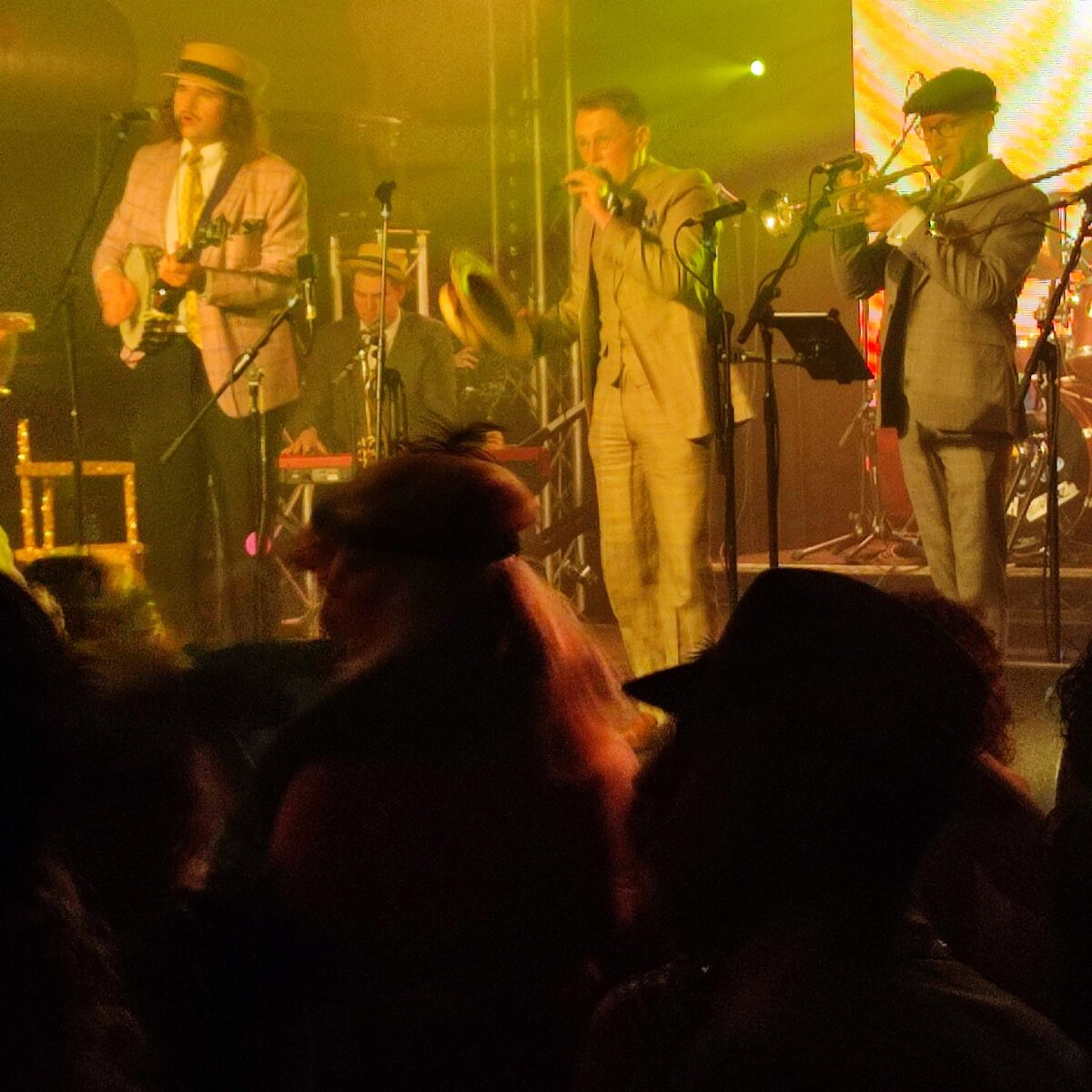By Sam Wise.
Saturday night saw the arrival in Southampton of a show born out of time, 1923 Prohibition Party, and I was privileged to speak to one of its stars, Martin Jarl, trumpeter, singer and manager of the band Swing’It in advance.
Martin is, unconventionally for a swing musician, from Norway. He explained his love of this very American music to me.
“Growing up, my mum used to take me to a jazz café every Saturday, and they were playing trad jazz, 20s-30s music,” he says. “I looked around and I wondered why everyone was so old!
“Not just the musicians, also the audience, and the music was fun and I thought, why aren’t young people into this?
“So, I thought, I should start doing it. I never expected music to be my career though.
“I studied engineering at university, but I also really wanted to play, and my skills weren’t where I wanted them to be. I took a year out, moved to London, and studied contemporary music for a year. Ever since then, I’ve been playing more and more, but none of the band thought that we would be doing what we are doing now, touring, playing to 100s of people”.
Arriving at The Engine Rooms, a vast hanger like club/venue in Southampton where I have previously seen rock acts, and attended roller discos, I was unsure what to expect.

The videos I had seen online from Prohibition Parties seemed to be set in more familiar, more timeless settings. As I strolled towards the venue, however, I began to feel like I had stepped back in time, as partygoers apparently from a bygone era surrounded me in their flapper dresses, winged collars, waistcoats and spectator shoes.
Entering the building provided some clashes, as the very 2024 security guards and cans of Red Stripe at the bar gave way to a crowd of flappers and dandy gents further into the venue.
Martin’s desire to bring this music to a younger generation has had some success; this wasn’t exactly a young crowd, but it was certainly an energetic one, bringing together people from their late 30s onwards united by a desire to drink and dance, and committed to doing it in a style that their grandparents might have recognised.
As we moved closer to the stage, the dancing became more impressive, as singles and couples presumably from local swing dance classes wowed the civilians amongst us with their rhythm and gymnastic abilities.
The concept of the 1923 Prohibition Party was to attract people who might be turned off by coming to a jazz concert. Instead, they positioned it differently, as an opportunity to go out, dress up, and have a great party, with people find themselves enjoying the jazz while they’re there.
Martin and his friends were attracted by not just the music, but also the aesthetics which have been so popular in recent years in the Peaky Blinders, The Great Gatsby, and similar shows.

There was around an hour of drinking and dancing as the place filled up, before the stage was taken by Champagne Charlie, a compere and comic singer of flexible gender who began to warm the crowd up.
Soon we were yelling “Champagne!” with one accord, as promises that “the time to get naked is nearly here” rang out. After a rousing rendition of “Patricia the Stripper” accompanied by the rest of the Swing’It band, Charlie welcomed Martin to the stage.
Martin had told me that every role in the band has two people in it, so that people can take time off for family, for illness or for other gigs, but the band’s schedule can continue. He didn’t mention whether there were two frontmen, but I was left assuming that there could not be.
The model of a serious, introverted Scandinavian engineer in our interview, resplendent in a polo shirt, Martin was transformed into a 1920s dilettante. Sharply dressed, talented with the horn, and funny in an unexpectedly bawdy way, the Martin Jarl of the stage that night really brought the fun.
Swing’It band consists of bass, drums, two trumpets, a trombone, a sax, a banjo and a keyboard played. Martin’s vocal style is as far from a Louis Armstrong as can be, but his strong tenor played well in a mix of original numbers, mostly concerned with the gentle art of drinking, and some classic standards such as Exactly Like You, and Sunny Side of the Street.
The keyboard player occasionally stepped up to the mic too, when a little more growling and roaring was required, and the band had us moving our feet the whole way.
The live music is really only a part of the appeal at the Prohibition Party however; perhaps the main attraction is how immersed you can feel in a different time. Steer your eyes away from the HVAC on the ceiling, and focus on the people around you, and it’s the 20s everywhere you look.
The band continues to swing; I asked Martin who inspired him as a trumpeter, and he confessed that while he has listened to a lot of Louis Armstrong, Chet Baker is as much of an influence, and he doesn’t really try to play like a swing era trumpeter. The other trumpet player (regrettably, the other band members don’t seem to be named anywhere) is a dab hand with a wahwah mute however, and as the band moves from jazz inflected pop that would sit well on the set of Baz Luhrman’s Great Gatsby to gems of the real era like Minnie the Moocher, the two of them swap licks so that you’re never left wanting for anything.
The show is more in the form of a cabaret than a band show, and the stage was graced later in the hour by burlesque artist Didi Derriere, who entered the stage, in the spirit of “work smarter not harder”, already in only some very brief lingerie, and removed almost all of that in short order, teasing for a little while behind ostrich feather fans before her big reveal.
As the band continued, they were joined at the end by flapper dancers The Gatsby Girls, bringing the stage to life in a final crescendo.
The drinking and dancing continued through the break, because really, that’s what 1923 Prohibition Party is; it’s a vintage dance party with a cabaret.
Certainly some people might wander off for a smoke and a chat, but the fun doesn’t stop just because the live music does. So the break isn’t really a break, and when it ended, the whole company was back to swing the audience once more, returning to a party which never stopped.
And you should go; you really should.
You can catch the party in London on the 17 February, and if we’re very lucky, maybe they will tour these parts again. And if you’re going, go hard. Dress up, show up, maybe even learn some dance moves.
I promise you, you’ll have one of the most fun nights you can imagine.
What’s really exciting is to realise that Martin is not done. This show is packing quite large venues across Europe (the Engine Rooms has a capacity of 800, and felt rammed), and it’s easy to imagine that it could go further, bigger, with higher production values. I wonder whether there might one day be an arena show that grows out of this, and if there was, I would be there.
- In Common is not for profit. We rely on donations from readers to keep the site running. Could you help to support us for as little as 25p a week? Please help us to carry on offering independent grass roots media. Visit: https://www.patreon.com/incommonsoton

